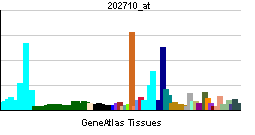BET1
| BET1 homolog (S. cerevisiae) | |||||||||||
|---|---|---|---|---|---|---|---|---|---|---|---|
| Identifiers | |||||||||||
| Symbols | BET1 ; DKFZp781C0425; HBET1 | ||||||||||
| External IDs | Template:OMIM5 Template:MGI HomoloGene: 38108 | ||||||||||
| |||||||||||
| RNA expression pattern | |||||||||||
 | |||||||||||
| More reference expression data | |||||||||||
| Orthologs | |||||||||||
| Template:GNF Ortholog box | |||||||||||
| Species | Human | Mouse | |||||||||
| Entrez | n/a | n/a | |||||||||
| Ensembl | n/a | n/a | |||||||||
| UniProt | n/a | n/a | |||||||||
| RefSeq (mRNA) | n/a | n/a | |||||||||
| RefSeq (protein) | n/a | n/a | |||||||||
| Location (UCSC) | n/a | n/a | |||||||||
| PubMed search | n/a | n/a | |||||||||
BET1 homolog (S. cerevisiae), also known as BET1, is a human gene.[1]
This gene encodes a golgi-associated membrane protein that participates in vesicular transport from the endoplasmic reticulum (ER) to the Golgi complex. The encoded protein functions as a soluble N-ethylaleimide-sensitive factor attachment protein receptor and may be involved in the docking of ER-derived vesicles with the cis-Golgi membrane. Alternatively spliced transcript variants encoding different isoforms have been described but their full-length nature has not been determined.[1]
References
Further reading
- Waters MG, Pfeffer SR (1999). "Membrane tethering in intracellular transport". Curr. Opin. Cell Biol. 11 (4): 453–9. PMID 10449330.
- Olsen JV, Blagoev B, Gnad F; et al. (2006). "Global, in vivo, and site-specific phosphorylation dynamics in signaling networks". Cell. 127 (3): 635–48. doi:10.1016/j.cell.2006.09.026. PMID 17081983.
- Rual JF, Venkatesan K, Hao T; et al. (2005). "Towards a proteome-scale map of the human protein-protein interaction network". Nature. 437 (7062): 1173–8. doi:10.1038/nature04209. PMID 16189514.
- Gerhard DS, Wagner L, Feingold EA; et al. (2004). "The status, quality, and expansion of the NIH full-length cDNA project: the Mammalian Gene Collection (MGC)". Genome Res. 14 (10B): 2121–7. doi:10.1101/gr.2596504. PMID 15489334.
- Hillier LW, Fulton RS, Fulton LA; et al. (2003). "The DNA sequence of human chromosome 7". Nature. 424 (6945): 157–64. doi:10.1038/nature01782. PMID 12853948.
- Scherer SW, Cheung J, MacDonald JR; et al. (2003). "Human chromosome 7: DNA sequence and biology". Science. 300 (5620): 767–72. doi:10.1126/science.1083423. PMID 12690205.
- Strausberg RL, Feingold EA, Grouse LH; et al. (2003). "Generation and initial analysis of more than 15,000 full-length human and mouse cDNA sequences". Proc. Natl. Acad. Sci. U.S.A. 99 (26): 16899–903. doi:10.1073/pnas.242603899. PMID 12477932.
- Zhang T, Hong W (2001). "Ykt6 forms a SNARE complex with syntaxin 5, GS28, and Bet1 and participates in a late stage in endoplasmic reticulum-Golgi transport". J. Biol. Chem. 276 (29): 27480–7. doi:10.1074/jbc.M102786200. PMID 11323436.
- "Toward a complete human genome sequence". Genome Res. 8 (11): 1097–108. 1999. PMID 9847074.
- Zhang T, Wong SH, Tang BL; et al. (1997). "The mammalian protein (rbet1) homologous to yeast Bet1p is primarily associated with the pre-Golgi intermediate compartment and is involved in vesicular transport from the endoplasmic reticulum to the Golgi apparatus". J. Cell Biol. 139 (5): 1157–68. PMID 9382863.
- Hay JC, Chao DS, Kuo CS, Scheller RH (1997). "Protein interactions regulating vesicle transport between the endoplasmic reticulum and Golgi apparatus in mammalian cells". Cell. 89 (1): 149–58. PMID 9094723.
- Hay JC, Hirling H, Scheller RH (1996). "Mammalian vesicle trafficking proteins of the endoplasmic reticulum and Golgi apparatus". J. Biol. Chem. 271 (10): 5671–9. PMID 8621431.
| This protein-related article is a stub. You can help Wikipedia by expanding it. |